Samsung 27-inch (Cf591) Curved Monitor With Amd Freesync - Review
Author: Adam Simmons
Appointment published: June 16th 2016
Introduction
Samsung now offers a range of monitors with curved screens – in fact they now seem to be pumping out more screens with a curve than without. As we noted on our review of the S27E650C, the bend is sometimes too subtle to really discover. In this case the inclusion of a 4000R bend did lilliputian to change the viewing experience. The C27F591FD boasts a more than distinctive curve, which at 1800R is 'more than than twice every bit curved' every bit previous models. Notation that this model is besides referred to equally C27F591F or LC27F591 of the CF591 series, with diverse regional suffixes. Some other new addition is back up for Adaptive-Sync (and hence AMD FreeSync). We put this monitor through its paces to observe out what the steeper curve brings to the table and also analyse its performance in key areas such equally contrast, color performance and responsiveness.
Specifications
This model features a 72Hz 27" SVA ('Super' Vertical Alignment) panel, with a relatively pronounced 1800R curve. True 8-scrap colour is supported aslope a specified 4ms grey to greyness response time (take with a compression of salt). Some of the key 'talking points' have been highlighted in blueish beneath.
Screen size: 27 inches
Console type: Samsung SVA (Vertical Alignment) LCD Console
Native resolution: 1920 x 1080
Typical maximum effulgence: 250 cd/m²
Color support: xvi.seven million (eight-$.25 per subpixel without dithering)
Response time (G2G): 4ms
Refresh rate: 72Hz (variable, with Adaptive-Sync)
Weight: four.40kg
Dissimilarity ratio: 3,000:ane (Plus 'MEGA' Dynamic Contrast)
Viewing angle: 178º horizontal, 178º vertical
Ability consumption: 36W typical
Backlight: WLED (White Low-cal Emitting Diode) with 'Active Crystal Colour'*
Typical cost as reviewed: £260 ($320 USD)
*Nosotros had originally surmised from the proper noun that this could exist some form of Quantum Dot solution for the backlight. Having spoken with those who work on such technologies it seems likely that 'Active Crystal Color' refers to the utilize of doped phosphors (i.e. enhanced phosphors) rather than Breakthrough Dots to somewhat enhance colour gamut.
Features and aesthetics
From the front, the monitor has a modern await with slender bezels. These comprise a very slender silver plastic outer bezel and a very thin blackness console border at the top and sides – a full thickness of ~7.5mm (0.30 inches) for both components. At the bottom there is a silver plastic lip which hides all but a sliver of panel border, a total thickness of ~17mm (0.67 inches). The stand base has a silver-coloured matte plastic cease, in a dish shape. This is fairly unconventional stand base design and does have upwards more desk space than is necessary, but it makes a handy place to keep a phone or something of that nature. Information technology almost looks like it should have a QI charger integrated into it – but it doesn't. Other noteworthy features at the front include a light matte anti-glare screen surface and the relatively steep (1800R) curve of the screen. Annotation that this appears greatly exaggerated on the images compared to when using the monitor in person. Both of these features are explored deeper into the review.
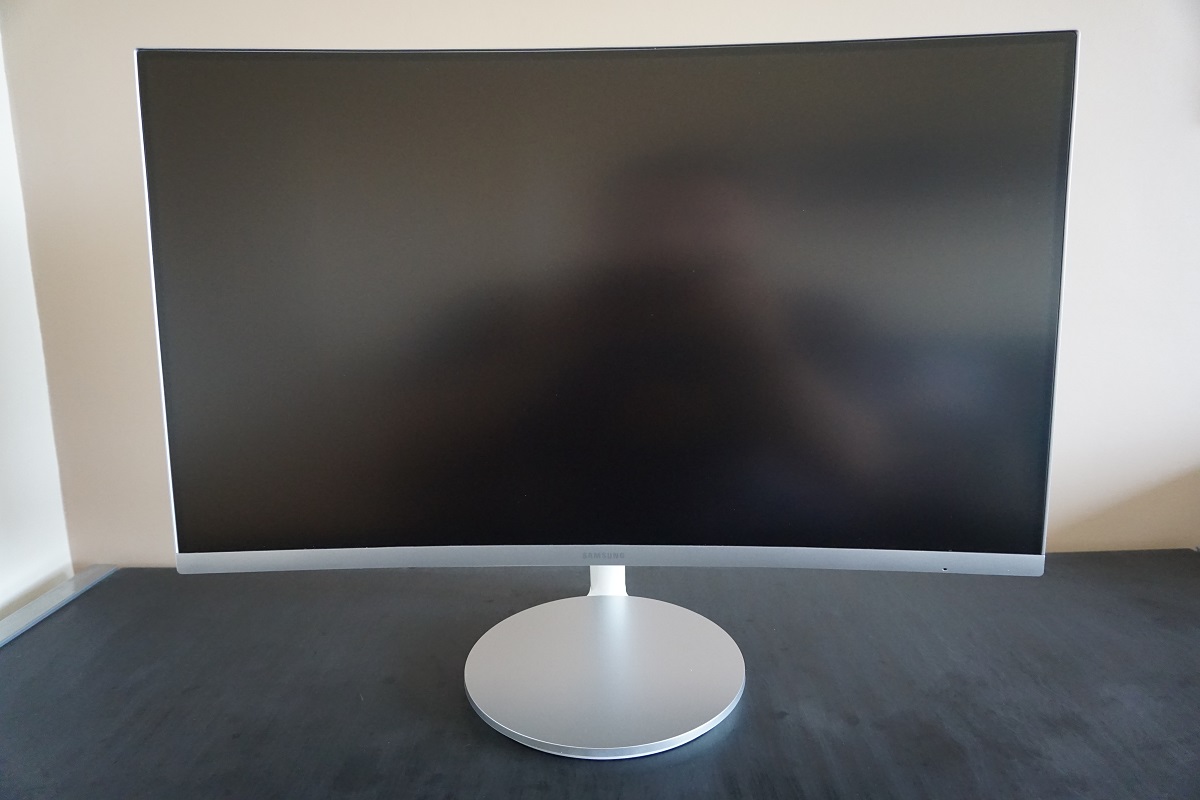

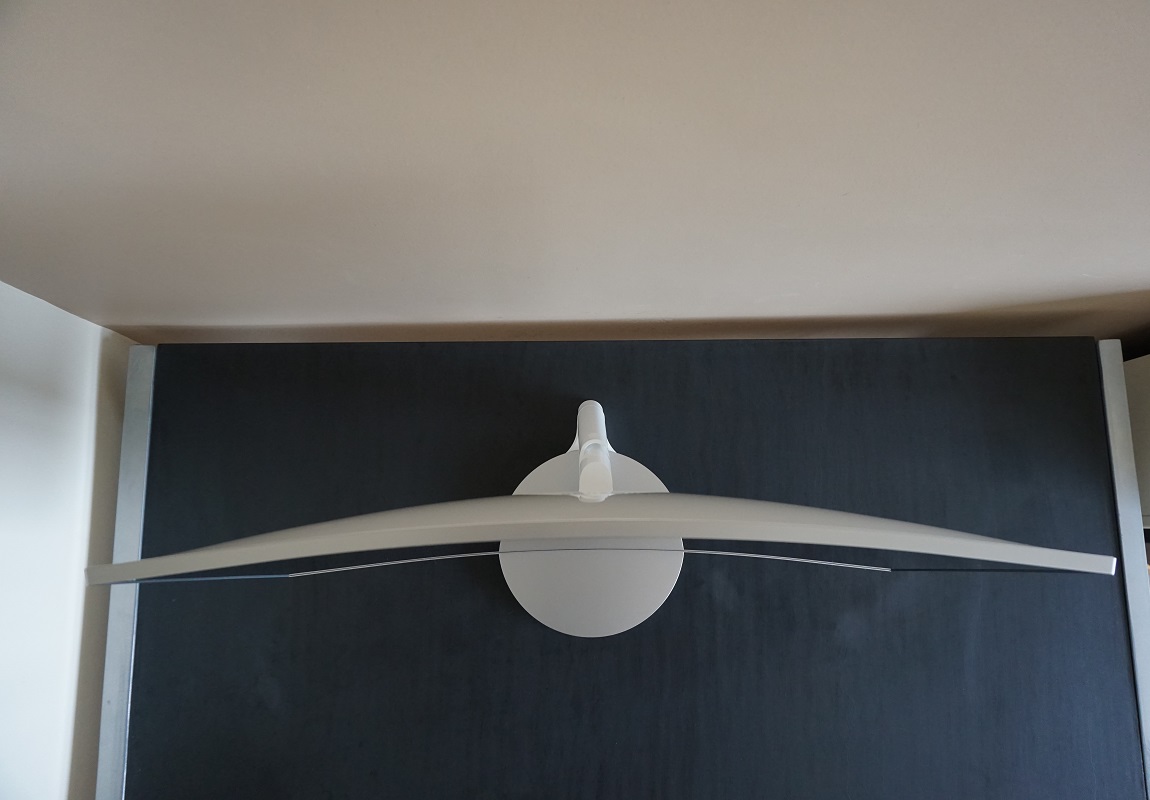
The OSD (On Screen Brandish) and power state of the monitor is controlled by a joystick (JOG button) located at the rear of the monitor, towards the right side as viewed from the front. This is a control system we always find quite intuitive on modern Samsung monitors, and this was no exception. The monitor has a small power LED at the right of the lesser bezel, which glows blue to betoken that the monitor is on (can be disabled in the OSD) and flashes if information technology enters a low power land. The video below runs through the menu system of the monitor and explores some of the key features.
From the side the monitor is fairly slender, sporting its curve nicely. Information technology measures ~10mm (0.39 inches) at thinnest point but lumps out centrally and towards the bottom in particular. The stand of the monitor offers tilt (ii° forrard, 20° backwards) equally the only ergonomic freedom. The total depth of the monitor including stand up is ~255mm (10.03 inches). The bottom of the screen clears the desk by ~100mm (iii.94 inches) with the top ~460mm (18.11 inches) to a higher place the desk.
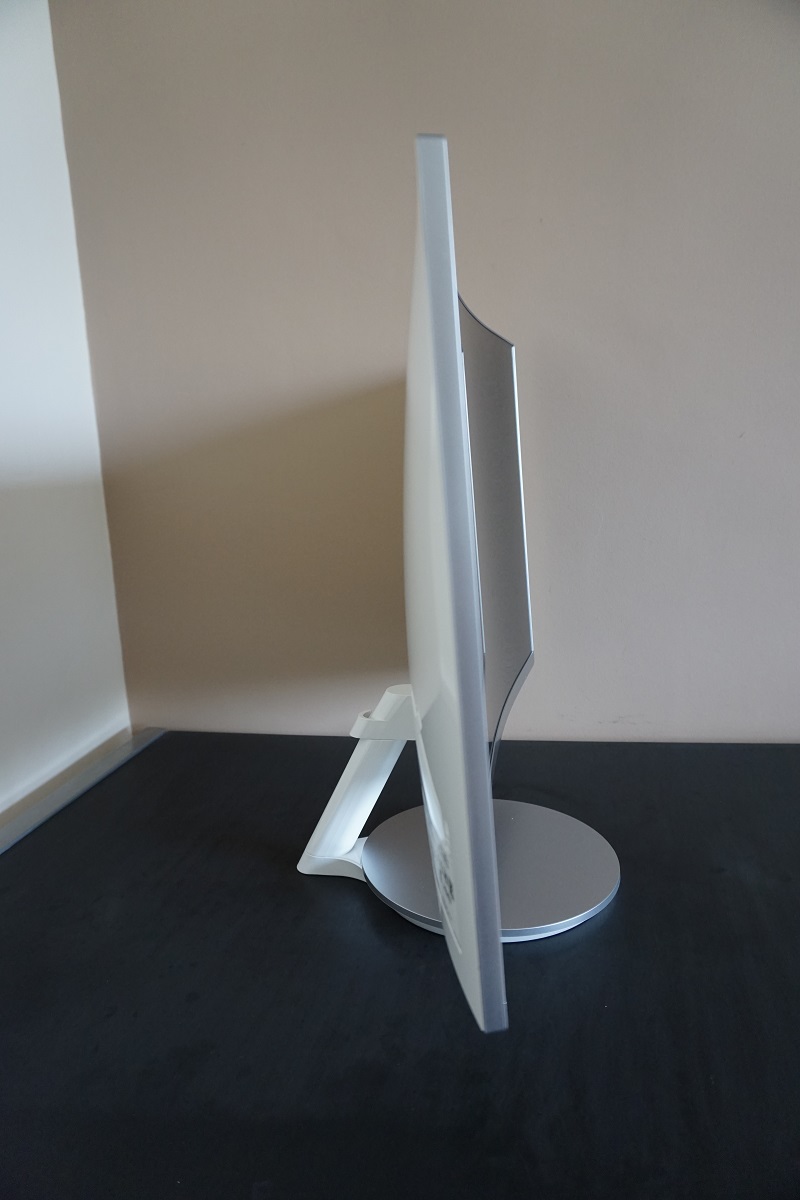
The rear of the screen, every bit obvious from a side aspect as well, is glossy white plastic. The JOG button can be seen from this attribute towards the bottom left, with the included stand up attaching nigh the bottom central region. There are no VESA holes at the rear, but some backwards-facing ports; DP one.2a (supports Adaptive-Sync), HDMI 1.4a (supports Adaptive-Sync), VGA, 3.5mm headphone jack, 3.5mm audio input and DC power input (external ability brick). There are also two down-firing 5W speakers and a G-Slot towards the far right. These speakers provide fairly rich sound output with pretty decent clarity and a fleck more of a bassy quality than most integrated speakers (using the 'Music' setting, at least). They certainly aren't short on volume either. In terms of overall quality, bass quantity and volume they tin't compete with a decent standalone speaker or headphone set, merely they are definitely usable and amend than many integrated speakers.
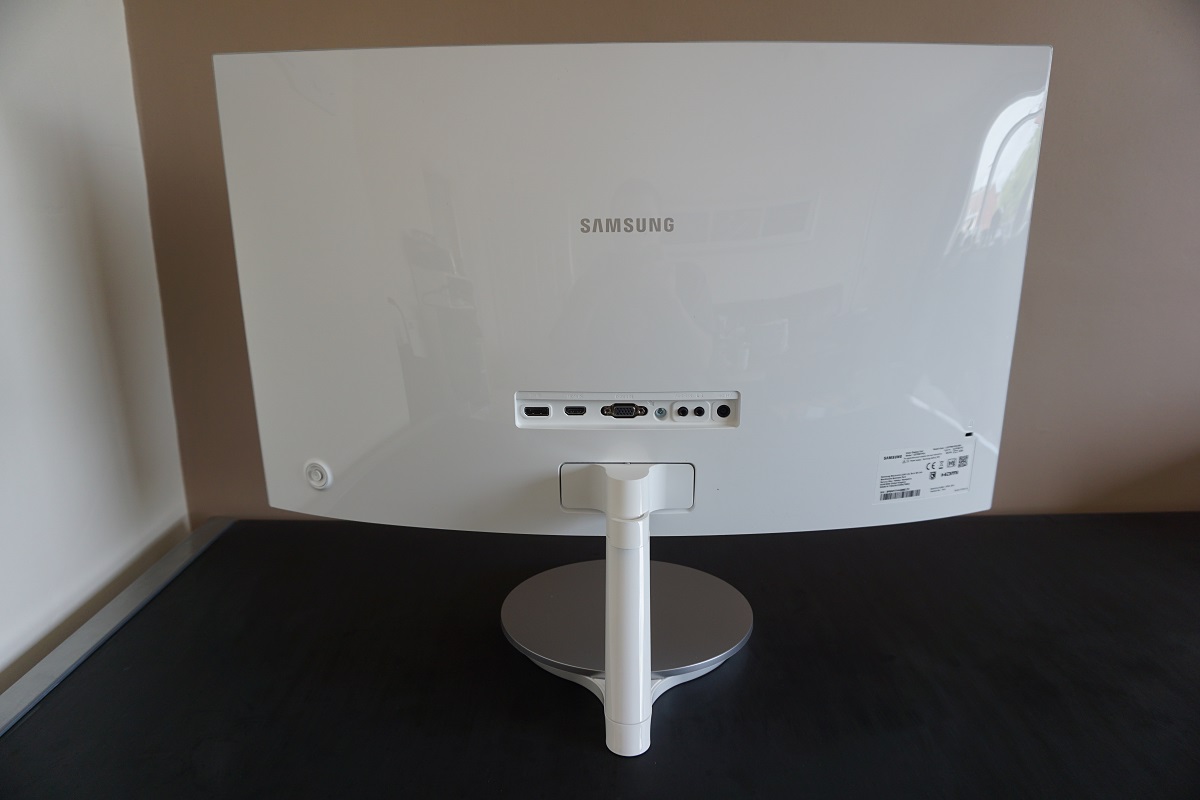
Note that the necessary power adaptor is included in the box. Standard accessories vary past region, simply generally an HDMI and DisplayPort cable will exist included.
Calibration
Subpixel layout and screen surface
As mentioned previously, a light matte anti-glare screen surface is used on this monitor. This has a adequately smooth surface texture, delivering an image that is gratis from obvious graininess even when viewing lighter content. External glare handling characteristics as well remain good. Although nosotros don't accept one to mitt for a side-by-side comparing, we're inclined to say that the image appears a touch smoother than on the older ('Eastward' series) 27" curved models. Not that they were bad in that regard anyhow.
![]()
The subpixel layout of the monitor is the usual RGB (Ruby-red, Green and Blue) stripe, shown above. You can meet that the subpixels perhaps appear a bit squat, which we take attributed to issues with sharpness or the introduction of interlacing patterns on older curved Samsung VA models. This model did not suffer a loss of sharpness or troublesome interlacing patterns as a issue of the squat subpixels. There were the faintest traces of interlacing in places, on some very light shades, but this was not as noticeable every bit on earlier models. Because this is something of a standard layout for both Mac and Windows machines, there'southward no demand to run ClearType as a Windows user or worry most text fringing on Mac systems. You may still wish to run the ClearType wizard to fine-melody according to preferences, however.
Testing the presets
Equally usual for a mod Samsung monitor, there is a selection of 'MagicBright' presets; 'Custom', 'Standard', 'Cinema', 'Dynamic Contrast' and 'Basic Color'. This final setting is an sRGB emulation mode, which cuts down on extension across sRGB in the colour gamut equally explored afterwards. There are also two settings that were introduced not also long agone to Samsung models; 'Centre Saver' and 'Game Way'. The former is designed to promote relaxing viewing whilst the latter provides excessive shade crushing, oversaturation and a more often than not inaccurate paradigm. We explore a selection of these modes alongside another settings in the OSD such equally 'Gamma'. The table below includes key readings taken using a Datacolor Spyder5ELITE colorimeter alongside general observations done by eye. Readings and observations were taken after the monitor was left to run for at least 2 hours.
The monitor was kept in its 'plug and play' state with no additional drivers or ICC profiles loaded – assume whatsoever setting not mentioned was left at default with the exception of our 'Examination Settings'. The test system used a Club3D Radeon R9 290 royalAce FreeSync-compatible GPU connected via DisplayPort. Note that in that location was a bug when setting the monitor to 60Hz (or 59Hz) via DP whereby the image appeared flooded (as if contrast was at '100' even when it wasn't). Nosotros therefore set the monitor to 72Hz for these observations. Note that the image was very like when HDMI was used, except that 60Hz worked every bit information technology should without everything looking flooded (so don't worry, games console users). Unfortunately, we were without an Nvidia GPU for the duration of the review so could non test behaviour when continued to an Nvidia GPU. There shouldn't be whatsoever concerns though equally HDMI will certainly piece of work every bit intended at 60Hz for Nvidia users. Furthermore, you should be able to set the monitor to 72Hz if preferred even when DP is used, avoiding any potential 'flooding' of the image, every bit we explore later on.
If y'all exercise decide to connect using HDMI, you should ensure the colour signal is corrected every bit detailed in this article. In addition to ensuring the graphics driver is doing the right matter, there's an boosted setting in the 'Picture' menu of the monitor's OSD called 'HDMI Black Level'. In one case yous've got the graphics driver using the correct 'Full Range 0-255 RGB' betoken you lot should ensure 'HDMI Black Level' is set to 'Normal' rather than 'Low'. Games console users should refer to the section of this article under the heading 'How do I set up my monitor for console gaming'. Interestingly enough our AMD GPU was fix to apply the correct 'Total Range 0-255 RGB' indicate past default and the 'HDMI Black Level' setting was actually greyed out. We could ostend by middle that everything was working correctly, and so nothing to worry about there. Nvidia GPU users will likely have to change the settings as above.
| Monitor Settings | Gamma (central average) | White point (kelvins) | Notes |
| Gamma = Mode1 (Factory Defaults) | 2.1 | 7352K | The image is very bright with a absurd-tint and strong saturation. The saturation levels, although strong, aren't anywhere near as intense on the whole as a 'wide gamut' (~Adobe RGB or greater) model. As is usual for a VA console, the saturation weakens slightly towards the flanks of the screen. This occurs to a bottom extent than you lot'd usually come across, every bit nosotros explore later. The overall variety of shades and vivid await will appeal for amusement purposes. |
| Gamma = Mode2 | 2.3 | 7375K | As to a higher place, merely extra depth to shades to to college gamma. Some shades appear too deep and some of the darker shades blend into black a bit too readily ('black crush' – to a greater degree than using 'Mode1' for gamma). |
| Gamma = Mode3 | 2.5 | 7373K | As above, just things are now far too deep with fairly extreme 'black crush'. Shade distinction is poor and overall representation inaccurate. |
| Color Tone = Warm2 | two.i | 4438K | This is an effective 'Low Blue Light' setting. The paradigm appears warmer and blue light output from the monitor is cut downward significantly. This setting is suitable for relaxing evening viewing, for instance. |
| Heart Saver Style | ii.half dozen | 4757K | This is an alternative 'Low Blue Light' setting. This locks off the effulgence control, sets the backlight to a dim effulgence setting, massively reduces static contrast and significantly weakens the blue colour channel. All this is intended to provide an image that is as relaxing as possible on the eyes, but it does look manifestly flooded due to the extremely low contrast. |
| Game Mode | 2.one | 7230K | As usual this setting provides significant oversaturation and excessive sharpness – information technology frankly looks ugly. This monitor has a naturally vibrant image, information technology doesn't need any artificial help whereby shades are pulled closer to the edge of the gamut to increase the saturation of shades that shouldn't exist highly saturated. Past pulling shades closer to the edge of the gamut, without increasing the gamut, you also have a significant striking to shade variety – things get crushed together. Effulgence is the only central prototype adjustment you tin can admission with this mode active. |
| MagicBright = Basic Color | 2.ane | 7376K | This is an sRGB emulation way, restricting the native colour gamut then that shades are presented within the sRGB are displayed more accurately on the whole. Unlike many such modes the contrast doesn't take a hit. This is a potentially useful mode for applications where a higher degree of colour accuracy is desired, only exist aware of VA limitations and the fact that colour controls are locked off in this style. |
| Examination Settings (modified every bit beneath) | two.1 | 6496K | As per 'Gamma1' reduced brightness and corrected white point. The image is vibrant and varied with a look that many users would detect pleasing for full general desktop use, gaming and movies. |
Out of the box the C27F591FD (CF591) provided a strikingly vibrant and rather brilliant image, simply had a noticeable cool tint. Gamma strayed just slightly from the desirable '2.2' bend, but non alarmingly and then and certainly not enough to sap the image of depth. There were other 'Gamma' settings which increased the gamma, but they strayed either slightly or far beyond 'ii.2'. There were two useful 'Depression Blue Light' settings, including 'Warm2' which maintained strong dissimilarity and 'Eye Saver Mode' which purposefully cut downward dissimilarity. The purpose of this is to reduce the fourth dimension the centre spends accommodating for changes in calorie-free (assuming ambient light levels aren't fluctuating too much, of form). We preferred 'Warm2' but like that Samsung has taken quite a unique and far-reaching approach with 'Center Saver' – something some users might appreciate.
There is likewise a 'Bones Color' setting, an boosted 'MagicBright' preset that is an sRGB emulation mode. Because the colour gamut of this monitor extends a off-white bit beyond sRGB, this sort of setting is useful to cutting downwardly on the actress saturation brought well-nigh by the untamed gamut. This setting locks off manual colour channel adjustments, although a colorimeter could still compensate for this on a software level. For full general use and entertainment purposes we actually liked the native gamut as it provided an extra dose of vividness without straying too far from the intended shades. This is very different to a model with Adobe RGB or wider gamut displaying sRGB content. We therefore employed the full gamut for our 'Test Settings', with the gamma tracking quite pleasing for our uses and complimentary from worrying deviations from the '2.2' bend.
Test Settings
Our test settings involved a meaning reduction in brightness alongside some changes to the color channels, with the default 'Mode1' used for gamma. Following these changes the epitome was nicely balanced, very rich and well-varied; inviting for general purpose and entertainment usage. Annotation that user preferences and individual units vary, then these settings are simply to be used as a reference and won't necessarily exist optimal in all cases. We've also included additional settings such as 'Response Time' setting and the refresh rate used just for reference. Anything not mentioned was left at default.
Brightness= 58 (co-ordinate to preferences and lighting) R= 50 K= 45 B= 43 Response Time= Faster FreeSync= Ultimate Engine Refresh rate= 72Hz
MagicBright= Custom
Contrast and effulgence
Contrast ratios
We used a BasICColor SQUID 3 (X-Rite i1Display Pro) to measure white and black luminance levels, from which static contrast ratios could be calculated. The tabular array below shows this data with various settings used, including those explored in the calibration section. Assume whatsoever setting non mentioned was left at default, save for the changes already mentioned in the calibration section and for our 'Test Settings'. Black highlights here indicate the highest white luminance, lowest blackness luminance and maximum contrast ratio recorded. Blue highlights show the results using our 'Examination Settings'.
| Monitor Settings | White luminance (cd/m²) | Black luminance (cd/k²) | Contrast ratio (ten:ane) |
| 100% brightness | 301 | 0.10 | 3010 |
| 80% brightness | 246 | 0.08 | 3075 |
| 60% brightness | 194 | 0.06 | 3233 |
| 40% brightness | 139 | 0.04 | 3475 |
| 20% effulgence | 83 | 0.03 | 2767 |
| 0% brightness | 25 | <0.01 | >2500 |
| Gamma = Mode2 | 298 | 0.10 | 2980 |
| Gamma = Mode3 | 297 | 0.10 | 2980 |
| Color Tone = Warm2 | 224 | 0.eleven | 2036 |
| Eye Saver Mode | 96 | i.71 | 56 |
| Game Mode | 321 | 0.eleven | 2918 |
| MagicBright = Basic Color | 321 | 0.11 | 2918 |
| Test Settings | 172 | 0.06 | 2867 |
The boilerplate contrast ratio with only brightness adjusted was 3112:1, excluding at '0%' effulgence where black point was lower than our instrument could accurately mensurate. This slightly exceeds the specified 3000:1 and is a strong functioning well beyond what not-VA LCDs tin can achieve. This contrast ratio provides a adept 'inkiness' to black and other deep shades whilst lighter shades stand out very nicely in darker surroundings. Contrast remained stiff at 2867:1 following the adjustments under our 'Exam Settings', whilst the 'Bones Colour' sRGB emulation mode had no measurable impact on contrast at all. The dissimilarity dropped to 2036:1 using the 'Warm2' Low Blue Calorie-free setting, whilst it dropped to a mere 56:ane using the 'Center Saver Mode' – in the latter instance, of form, this drop is entirely intentional. The maximum luminance recorded was 321 cd/one thousand², beyond the 250 cd/grand² specified. Meanwhile the minimum luminance recorded was a very low 25 cd/m², providing a 296 cd/chiliad² luminance adjustment range with plenty of usable values.
There is also a defended 'MagicBright' preset called 'Dynamic Contrast', which allows the backlight to adjust its intensity based on the overall level of light or dark on screen. The backlight adjusts as i private unit of measurement, as usual, so just works on averages across the screen. This setting tended to provide excessive brightness even during mixed scenes, even where enough of dark shade were included. Information technology did dim adequately effectively for predominantly night content. We don't like such settings and adopt transmission control of the backlight, simply it's there if you wish to use it.
PWM (Pulse Width Modulation)
This monitor does not utilise PWM (Pulse Width Modulation) at whatsoever brightness level and instead uses DC (Directly Current) dimming. The monitor is therefore flicker-free equally advertised, even at depression brightness settings. This will come as welcome news to those sensitive to the effects of PWM.
Luminance uniformity
Nosotros observed a black background in a dark room and observed no obvious backlight bleed. There was a scrap of clouding towards the lesser, only this was even so modest. It should be noted that individual units may vary in this regard, just as the best light blockers VA panels do tend to be relatively strong in this area. The paradigm below was taken from a couple of metres back to eliminate so-called 'VA glow'. This is a argent-purple glow appears from a normal viewing position towards the lesser of the monitor, especially near the corners. It becomes more noticeable from decentralised viewing angles, as demonstrated later in a video. It is very different to 'IPS glow' every bit it is nowhere about equally intense or obvious.
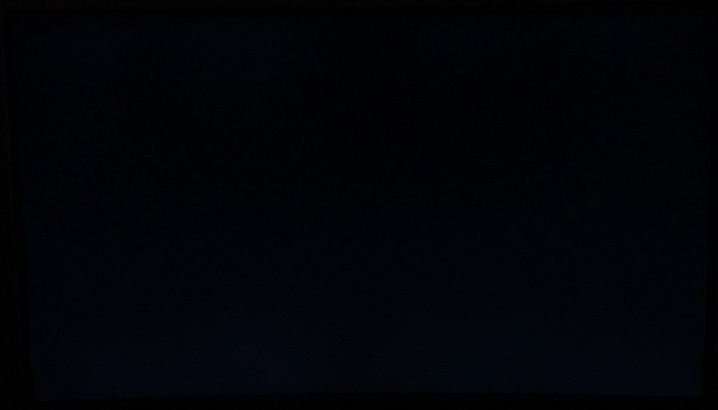
The Spyder5ELITE was used to analyse the uniformity of lighter colours, represented by 9 equidistant white quadrants running from elevation left to bottom right. The tabular array below shows the luminance recorded at each quadrant alongside the percentage deviation between a given quadrant and the brightest point recorded.
The luminance uniformity of the screen was pretty reasonable on the whole. The brightest bespeak recorded was 'quadrant 5' in the heart of the screen (161.1 cd/m²). The greatest deviation from this occurred at 'quadrant 2' to a higher place centre (132.9 cd/g² which is eighteen% dimmer than middle). A 12% difference was recorded at 'quadrant vii' towards the bottom left (141.1 cd/grand²). Elsewhere brightness was between iv-10% of the central value. Note that private units vary when it comes to uniformity and in that location may be further deviations across the measured points. The contour map below represents these deviations graphically, with darker greys representing lower luminance and therefore greater deviation from the central bespeak than lighter greys.
Nosotros also measured the colour temperature (white indicate) uniformity of the same ix quadrants. Deviations here are assigned DeltaE values, with college values showing greater divergence from the 6500K (D65) daylight white point target than lower values. A value higher up DeltaE 3 is considered significant deviation that some users would readily find by eye.
The results here were strong, without whatsoever significant deviations recorded. The highest divergence recorded was DeltaE 2.vii towards the bottom right. Yous tin can expect some deviation between individual units and in that location may also be deviation beyond the 9 points measured. Also bear in heed that there tin exist some slight shifts in perceived color temperature based on viewing angle weaknesses on VA panels such as this.
Contrast in games and movies
The contrast performance was excellent on Battlefield 4 (BF4). Dark areas on this game, such as gloomy underground tunnels, appeared suitably deep and atmospheric. There was merely a piddling touch on of 'black crush'. This is related to VA gamma behaviour; whereby nearly-black shades appear to blend into one another if the screen is viewed from straight in front but might exist distinct if viewed slightly from the side (or if observing content near the edges of the screen). Fortunately, this was about as subtle as we've seen from a VA panel. Some adequately subtle details such every bit grouting in bricks on the underside of bridges (in darkness and shade) were still visible, although were more than distinct if you moved your head to ane side. Vivid shades contrasted brilliantly with their darker surroundings, such every bit roaring flames and gunfire. Coupled with the fairly smooth screen surface, they looked quite 'pure' every bit well.
Dirt Rally also impressed every bit far as contrast was concerned, with first-class depth to dark shades and bright shades which penetrated through nicely. Racing at night on this game, especially without headlights, generates a level of darkness that isn't always replicated on other titles. This proved a good test of how pure and atmospheric nighttime areas could wait. In this respect things were clearly in 'VA just' territory as far as LCDs are concerned. At that place was but a little bit of 'VA glow' towards the lesser of the screen, but the overall depth of blackness and other dark shades far surpassed IPS or TN panels. This strong contrast also helped give vegetation and other objects a distinctive construction, with shadows and fine nighttime details contrasting very nicely with the brighter shades alongside.
On the Blu-ray of Star Wars: The Force Awakens, the stiff contrast functioning was once more evident. There were many scenes involving an intricate mixture of lite and dark elements – lightsabers and explosions set up against the depths of space for instance. These elements shone with brilliance, whilst the dark surroundings had very pleasing depth and quite an 'inky' await to the very darkest shades. These bright elements appeared prissy and smooth with no obvious graininess imparted from the screen surface.
Lagom contrast tests
Lagom'due south dissimilarity tests were used to analyse specific weaknesses in contrast performance which may not have been identified during other testing. The following observations were made.
- The dissimilarity gradients were splendid, with distinct brightness steps throughout. The darkest blue block was slightly less visible than it might exist ideally, from a normal viewing position. It became clearer if yous raised your caput or lowered the position of the block on the screen slightly.
- Operation on the black level test was stiff. The first few blocks blended into the background quite readily, every bit y'all would expect from the '2.2' gamma bend. The remaining blocks were distinctly visible. If y'all move off-angle the kickoff few blocks were actually revealed and indeed all blocks appeared to accept a sort of shimmering appearance as viewing angle inverse. This is typical for a VA panel and related to viewing angle restrictions. In that location was no noticeable dithering.
- Performance in the white saturation test was very good as all checkerboard patterns were visible against the background. The final block was not equally visible as it could be, although the screen surface did non impart noticeable graininess over this which is good.
- The greyscale gradient appeared very smooth, gratis from obvious banding or noticeable dithering.
Colour reproduction
Colour gamut
The Samsung C27F591FD'southward (CF591'southward) color gamut (red triangle) was compared to the sRGB color space (green triangle). Equally you lot tin see from the gamut representation beneath, the monitor comprehensively covers sRGB and offers a off-white fleck of extension beyond this (>100%). This gives the monitor the potential to output all shades inside the sRGB colour space, with a chip of extra saturation, lending itself well to general-purpose and entertainment utilise. It does non extend as far as 'Adobe RGB' in the green corner of this particular diagram and certainly doesn't offer the sort of extended colour gamuts shown by the likes of the Dell UP2716D. So it is not to be considered a wide gamut model in that respect.
The monitor also offers a 'MagicBright' sRGB emulation setting called 'Basic Color', which every bit you can encounter below chops down the colour gamut significantly. There is actually some nether-coverage (96% sRGB measured), especially in the ruddy corner of this diagram. This cuts downwards saturation and allows potentially more than accurate representation of shades within the sRGB color space. If you lot're after accurate sRGB reproduction it might arguably be better to simply use the native gamut of the monitor and tame the shades a fleck using a colorimeter, however.
Colour in games and movies
Color reproduction was pleasing on BF4, with a very rich and varied await. There were some exceptionally vibrant-looking reds and oranges (roaring flames), whilst the in-game HUD markers showcased a squeamish intense range of blues, reds, yellows and greens. Although shades did lose a bit of saturation towards the flanks and lesser of the screen, this was quite subtle for a VA console – helped perhaps by the curvature of the screen. There were some pleasingly brilliant greens alongside more muted pastel shades and some good earthy browns. Things certainly looked vibrant, but did not have the garish oversaturated quality you lot'd see from a wide gamut (~Adobe RGB colour space) screen displaying this game.
Colour reproduction was equally pleasing on Clay Rally. The racing environments appeared natural, despite an extra bit of saturation in places from the colour gamut. The stiff shade diversity and advisable muted expect of the earthy browns and khaki shades was maintained, whilst some of the lusher and deep greens didn't take that inappropriately brilliant and bold quality that wide gamut screens tend to produce. The machine liveries and advertizing effectually the runway benefited from this unmistakably vibrant look, with some truly stunning colours. Some orange shades appeared a flake too deep, just didn't take the same intense crimson hue to them that some wide gamut screens tend to produce. The vibrancy was particularly impressive where bright shades (such equally pinks, greens and yellows) were painted on confronting darker backgrounds, standing out beautifully thanks to the combination of strong dissimilarity and generous colour gamut.
Nosotros also found the colour reproduction pleasing on the Blu-ray of Star Wars: The Force Awakens. At the adventure of repeating what we said in the contrast section, the scenes where calorie-free and night met (no pun intended) were especially impressive. The intensity of the ruby-red and blue lightsabers was particularly hit here. The vast areas of sandy desert appeared with largely appropriate saturation, not taking on an inappropriate red hue. The saturation did weaken slightly towards the far edges and near the bottom of the screen, equally is typical for a VA panel. This weakening was more subtle than you'd usually observe, however. Skin tones also appeared largely as they should, perhaps merely a petty more than saturated than they should in places but non in that 'sunburnt' wide gamut way.
Finally, we assessed color performance on the Blu-ray of Futurama: Into the Wild Green Yonder. With large areas of a unmarried shade, this motion-picture show is an fantabulous test for colour consistency and shade variety. In this respect the monitor put in a pleasing performance, especially for a model with a VA panel of this size. Consistency was not equally potent equally on IPS-blazon panels – if you observed a character's skin tone at unlike areas of the screen, for example, the saturation became weaker towards the sides and bottom equally noted elsewhere. The bulk of the screen showed impressive richness, though, and it did seem that the bend helped enhance this aspect of colour functioning. Every bit a result of this, the monitor was able to brandish a expert range of shades with advisable distinctiveness. Even closely matching skin shades, for example, had quite a unique identity and appeared more or less as they should throughout the screen. The strong vibrancy was also very much evident on this screen, with some exceptionally center-catching neon and deep shades. The saturation levels were non so uncontrolled as to make pastel shades appear far likewise deep or patently inaccurate, either, which is pleasing.
Viewing angles
Lagom'southward tests for viewing angle tests were used to help further explore viewing angle operation and color consistency. The following observations were made from a normal viewing position, with optics effectually 70cm from the screen.
- The royal block appeared regal for the most office, with a bit of a pink hue towards the very edges and the lesser of the screen. This pinkish hue shifted with head movement.
- The carmine block appeared rich red throughout, with just a footling bit of saturation loss at the very lesser just no obvious pink tint.
- The green cake appeared a fairly rich lime light-green throughout with a scrap of a stronger yellowish tint at the very bottom.
- The bluish cake appeared deep blue throughout.
- The Lagom text appeared blended grey for the most function, with a bit of red striping towards the bottom and edges. This was less obvious than usual for a 27" VA panel and free from the ready orangish, red and green shifts observed on a TN panel. The following image gives an impression of how this test appeared from a normal viewing position. Note that the pressure marking towards the bottom left was damage caused by a previous tester and would not be expected on a normal undamaged unit.
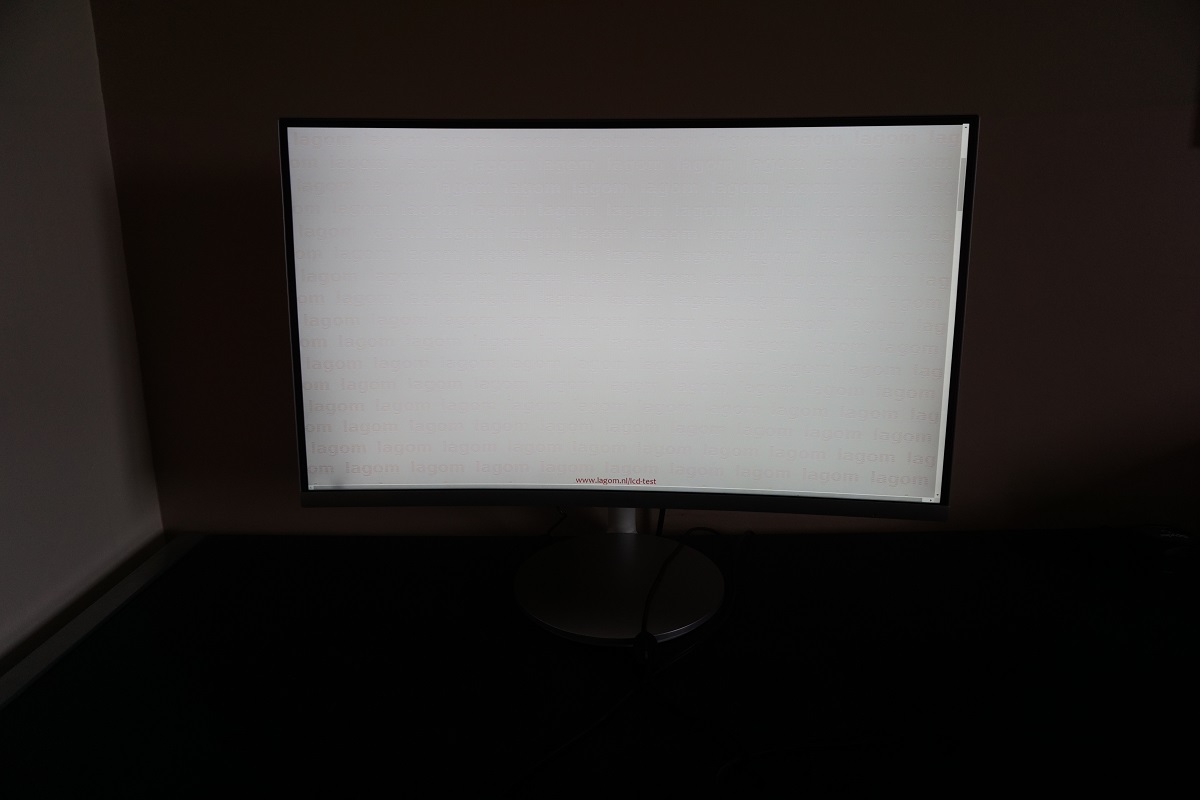
The video beneath shows this text test, a mixed desktop background and night desktop groundwork from a multifariousness of viewing angles. Notation the 'VA glow' mentioned previously, which appears to bloom out a bit off bending. It does non do this to anywhere near the same extent that 'IPS glow' would.
Responsiveness
Input lag
Using a sensitive photographic camera and small tool called SMTT 2.0, we compared the latency of the C27F591FD (CF591) with a range of monitors of known latency. By taking over 30 repeat readings to heighten accurateness, we measured 6.70ms (over 1/3 of a frame @60Hz) of input lag. We did non measure a significant difference in input lag at 72Hz and don't have the means to accurately measure out input lag whilst FreeSync is doing its affair. This value is influenced both by the chemical element of input lag that you experience (indicate filibuster) and the element that y'all see (pixel responsiveness). This value indicates a very depression signal delay that shouldn't impede gaming performance.
Perceived mistiness (pursuit photography)
In this commodity we explore the central concepts related to monitor responsiveness. Main amongst these is the concept of perceived blur and how information technology is not but the pixel responsiveness of a monitor that contributes towards this merely also the move of your eyes as you track movement on the screen. This 2d factor is oft the predominant cause of perceived mistiness, in fact. We also explore 'pursuit photography', a method of image capture which reflects both of these elements of perceived mistiness rather than only showing the influence of pixel responsiveness.
The images below are pursuit photographs taken on the UFO Motility Test for ghosting, with the test running at the default speed of 960 pixels per 2d. Such a speed is practical for taking such photos and highlights any problems on the exam nicely. The beginning cavalcade shows results with the nighttime cyan background whilst the 2d column shows the medium cyan background (top and middle row of the test, respectively). All response time settings on the monitor were tested as well as a capture with the monitor running at 72Hz, which this monitor volition likewise practice comfortably as we'll come onto later. The bottom image shows a 'Fast 60Hz reference', which is a Samsung S27A750D set to full effulgence (forces DC dimming, without flicker) and 60Hz using its 'Faster' response time setting. This reference shows how things should look in this test at 60Hz where movement blur due to eye (photographic camera) motion is the but real limiting factor.
When using the 'Normal' setting, there is a fair degree of trailing behind the object in improver to moderate blurring of the object itself. This abaft is attributable to slower than optimal pixel responses, whereas the blurring of the object itself is down to middle (camera) move. The trailing is more pronounced with the dark cyan background due to pixel responses beingness particularly slow for these transitions. Using the 'Faster' setting offers a marginal reduction in trailing and changes the nature of the trailing a fleck. There appears to be a bit of a 'dingy' quality to information technology – this actually indicates a piffling bit of overshoot (changed ghosting) due to fairly high levels of grey to gray acceleration being used. The 'Fastest' setting shows more than extreme overshoot, with obvious colourful inverted trails backside the UFOs.
When observing the monitor nether more than realistic and varied testing scenerios (such as games), information technology becomes clear that the 'Faster' setting does cut down on conventional trailing quite a flake compared to the 'Normal' setting. And the merchandise-off of that – slight overshoot in places – is really the lesser of two evils. Having established that this is the optimal setting to employ, we also tested the monitor at 72Hz using this setting. On these captures things really wait quite similar to 60Hz. The object is perhaps a fleck more than compact (it appeared so when observing information technology directly) but the abaft remains very much the same. Essentially motion blur due to eye movement is cut downward just a piffling from the increased refresh rate, but pixel responsiveness remains a limiting factor as is usual for VA models. Something not shown here is how the monitor actually feels when you interact with the game world – 72Hz provides a slightly more 'continued' feeling in that respect.
Running a custom resolution (overclocking)
The monitor will comfortably run at up to 72Hz at 1920 10 1080. If you enable FreeSync in the OSD, information technology will automatically default to 72Hz. If you're running an Nvidia GPU, you lot can set up a custom resolution to 'overclock' the monitor to 72Hz. Doing so does non have negative implications for the image such as changes to gamma, dissimilarity or colour temperature nor does it cause frame skipping. If you try to gear up the monitor to a higher refresh rate, such as 75Hz, you are given an 'input not support' message. This seems to occur regardless of connection used and timings. The video below shows you how to ready the monitor to 1920 x 1080 @72Hz, by creating a 'custom resolution' – for users who are unable to use FreeSync.
Because the monitor is designed to run at 72Hz, this is to be considered a 'mild' overclock that is completely inside manufacturer tolerances. There is minimal run a risk involved and in all likelihood the monitor will last for its useful life in much the same style as if information technology was run at 60Hz. The full general advice nosotros give at this stage as to be aware that overclocking is something which y'all practice at your ain risk. The risk may well be very low, especially as the monitor is conspicuously designed to run at 72Hz, but we take no liability should anything happen to the monitor which may or may non be due to running information technology at an increased refresh rate.
Responsiveness in games and movies
On Battlefield 4 there was quite a bit of motion blur, noticeable at all paces of activeness (whether running about as a solider or zipping about in a vehicle). Eye motility linked to refresh charge per unit was the main cause of this, but at that place was certainly an influence of slower than optimal pixel responses in places. Many pixel transitions occurred quickly enough so that there was but a trivial if any additional blur added to what you'd perceive on the best 60Hz or 72Hz LCDs for responsiveness. The perceived mistiness increased in places due to some pixel transitions being introduced that the monitor can't perform every bit rapidly. This was especially noticeable where dark shades were involved in the transition, such as moving by a dark and shaded building with a adequately brilliant blue or grey sky in the background. The building (object) had a scrap of extra abaft behind it. Yous could mayhap describe it as slightly smeary in its advent, although it didn't take the sort of extended (nigh smoke-like) smeary appearance that such transitions have on slower VA models. At that place was a bit of overshoot in places as well, but nothing particularly eye-catching or agonizing. When moving thermal eyes with white hot objects against cooler medium or darker grey backgrounds, for instance, you lot could meet a slight black tint to the trail behind the objects. And a similar trailing could be observed on the map 'Paracel Storm', with tree trunks set against a stormy sky having a fairly noticeable (to our eyes) semi-transparent blackness trail to them that did non appear as a alloy of the background and object colour.
We fabricated similar observations on Clay Rally. It was again the instance that most of the perceived blur could be attributed to center motility, simply at that place were some weaknesses in pixel responsiveness in places. This was almost noticeable when driving at night and nighttime shadowy objects such as copse silhouetted the slightly brighter sky. Yous could meet a more pronounced near smeary trail backside the objects – but once again, these were more than brusk-lived and not as obvious equally on some VA panels. There was also a chip of overshoot; something not anybody would notice and more often than not quite subtle rather than being something that jumps out at you.
Overall it seems that the C27F591FD (CF591) provides quite a good balance in terms of pixel responsiveness, particularly for a VA model. About transitions are snappy enough to have limited influence on perceived blur, whilst the acceleration is non and so excessive as to introduce obvious widespread overshoot. In that location are definitely imperfections and some slower than optimal pixel transitions, but as far as VA models goes this is i of the meliorate ones for gaming functioning. We also tested our Blu-ray film title for responsiveness and didn't come up beyond any obvious limitations there. The ~24fps at which the films run was really the primal limiting factor, not anything that was impeded past the monitor itself.
FreeSync – the engineering science and activating it
AMD FreeSync is a variable refresh rate technology supported by sure AMD GPUs (such equally these and future models), which makes use of VESA Adaptive-Sync. This is a capability integrated into some DP one.2a and HDMI i.4a port controllers, such equally those found on the Samsung C27F591FD (CF591). Equally with Nvidia G-SYNC, this allows the GPU to communicate with the monitor to allow information technology know what frame rate the content is currently running at. The monitor is then able to dynamically adjust its refresh rate to lucifer this, where possible. Doing then eliminates the stuttering (VSync on) or tearing and juddering (VSync off) that occurs where the frame rate and refresh rate are misaligned. Although it isn't something nosotros are able to accurately measure, there is too a reduction in latency compared to running VSync enabled, in the variable refresh rate environment (i.e. frame rate below refresh charge per unit limit of monitor).
Dissimilar with G-SYNC, a split 'G-SYNC board' or similar is not required and instead the existing scaling and monitor electronics are used. This reduces price to both the manufacturer and is an easier pick for manufacturers to implement with their designs – hence why the number of 'FreeSync' (uniform) displays dwarfs the number supporting G-SYNC. Every bit noted higher up the CF591 supports Adaptive-Sync and therefore AMD FreeSync via both HDMI 1.4a and DP 1.2a. Our test system uses a Club3D Radeon R9 290 royalAce, which is compatible with the technology. AMD's recent drivers include Radeon Software Red, which makes activation of the technology very uncomplicated. So simple, in fact, that it should exist automatically enabled when you outset plug the display in. To check this, open 'AMD Radeon Settings' and click 'Display'. You should then ensure that the get-go slider, 'AMD FreeSync', is gear up to 'On'. If you hover over this, it volition as well report the variable refresh rate display supported by the display. Annotation that the image below is for a different monitor and is just used here for reference.

Notation that in that location are two 'FreeSync' settings on the Samsung, found in the 'System' section of the OSD; 'Standard Engine' and 'Ultimate Engine'. The 'Standard Engine' offers support for a variable refresh rate range of 58 – 72Hz, whereas 'Ultimate Engine' supports 48 – 72Hz. There didn't seem to exist any drawbacks to using the latter option and the broader refresh rate range information technology supports, and then nosotros suggest users simply stick with that. Outside of this range, the GPU respects your selection of 'VSync on' or 'VSync off' in the graphics driver. With 'VSync on' the frame charge per unit will not be allowed to rise above 72fps, with VSync activating automatically at this point and imposing the usual latency punishment when it does and then. With 'VSync off' the frame rate is complimentary to ascent above 72fps (72Hz refresh rate ceiling of the monitor). This volition deactivate FreeSync and cause fierce and juddering which some users would find bothersome.
VSync is configured in the 'Gaming' department of 'Radeon Settings', where information technology is referred to every bit 'Wait for Vertical Refresh'. This can either be set globally nether 'Global Settings', or alternatively for each game championship on its own. The default is 'Off, unless application specifies' which means that VSync is only active if you enable information technology within the game itself, if such an option exists (it usually does). It might not exist called 'VSync' but may be referred to every bit 'sync every frame' or something like that. Nearly users volition probably want to enable VSync when using FreeSync to ensure that they don't become whatever trigger-happy. One of the final two options in the list, shown in the image below, would therefore exist preferable.
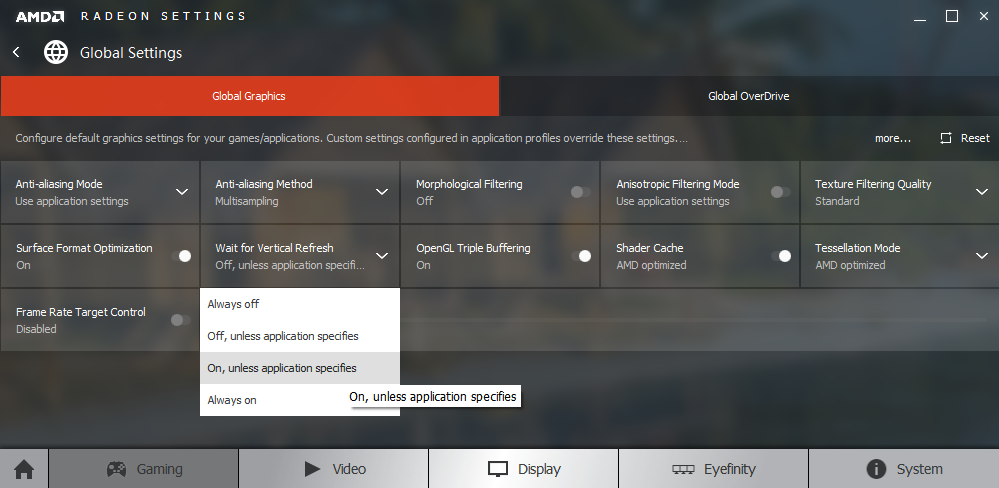
There are a couple of concluding points to note. Firstly, the application must be running in fullscreen mode, not a window (borderless or otherwise). Secondly, this monitor does not provide whatever obvious indication that FreeSync is actually agile such as an LED light or on-screen notification. You will simply accept to assume that it is working – provided you've activated the setting in the OSD and Radeon Settings, and then information technology certainly should exist. And finally, FreeSync can merely remove stuttering or juddering from frame and refresh rate mismatches and can't compensate for other issues caused by network latency, lack of retentiveness and suchlike.
FreeSync – the feel
Usually when we test FreeSync it is on monitors with a college refresh rate and/or college resolution, which provides to be potentially rather demanding. It is not too hard to achieve a consequent 72fps (to friction match 72Hz) at the 1920 x 1080 resolution using a moderately powerful GPU and adequately sensible in-game settings. There are still some dips that can exist expected hither and there, though, particularly on more than demanding titles. It also allows yous to creepo up the detail settings a scrap if you have the headroom to exercise then – and yous don't need to worry about those slight dips below 72fps that you might experience. Note that sensitivity to tearing and stuttering varies, then some users won't find the deviation as hit equally others. It'due south very subjective, so note that the observations beneath are just our observations as seasoned reviewers with a great heart for this sort of thing.
The offset championship we decided to test was Tom Clancy's The Partitioning, which is a fairly graphically demanding title depending on the settings used. We used fairly modest settings, with which the frame charge per unit tended to fluctuate between around sixty – 72fps. With FreeSync disabled there was (to u.s.a.) obvious stuttering or trigger-happy, making the experience quite jarring and disrupting the 'flow' of gameplay. With FreeSync enabled, the refresh rate was matched to the frame rate and such unwanted aspects were eliminated. There were times where the activity intensified such that the frame charge per unit dropped further. You lot could definitely feel and meet the effects of this (i.eastward. increased motion blur, decreased connected feel) and then the lower frame rates lone were quite jarring in a mode. There were times when the frame charge per unit fifty-fifty dipped momentarily below the 48fps (48Hz) floor of performance for the monitor, leading to violent or stuttering equally you'd meet on whatever monitor.
We also tested GTA V (One thousand Theft Auto five), which again has the potential to strain a poor little Radeon 290 even at the Full HD resolution. Using fairly high settings, the frame rate tended to hover somewhere around 65 – 72fps, merely not always reaching 72fps. Even these small drops from what would exist the static refresh rate of the monitor crusade bothersome tearing, juddering or stuttering without FreeSync. With the technology enabled everything had that sort of 'frame rate at refresh charge per unit' flow to information technology, without any such interruptions. Occasionally the frame rate dropped lower than this, sometimes closer to 50fps. The feel here was certainly much nicer than without FreeSync enabled, simply the decrease in frame rate could notwithstanding be felt. The level of motion blur was increased and interactions with the game globe felt a fleck more sluggish.
The bend
Samsung are marketing curved screens quite heavily at the moment – indeed it's something that began with some of their 'E' series models last year. They're keen to point out that having a concave curve to the screen is more than natural and comfy on the eyes. That's considering the edges of the screen are brought closer to the eyes (i.e. distance from eye to edges of screen decreased). We've reviewed the S27E590C, for example, which had a gentle 4000R curve. This proved to be then subtle that it barely changed the experience at all – it didn't really add much or take much away from the experience. Such a gentle curve was the norm for their curved 24 – 27" 'E' series models.
The C27F591FD (CF591) brandishes a steeper curve; at 1800R. Begetting in mind a lower 'R' value indicates a steeper curve; this makes it 'over twice as curved' every bit the previous models. The bend certainly proved more than noticeable this time around, but despite how it may appear on paper and indeed some shots (especially when taken from a non-cardinal angle) the curve remained a relatively subtle affair. It certainly wasn't sufficient to make the monitor feel all that different when we used it – which is practiced in a manner, as nosotros plant it very natural and adapted to information technology very readily indeed. If the marketing is to exist believed, then information technology besides has the potential to enhance viewing comfort. For designers or those who piece of work with straight lines and shapes, nosotros could certainly see how this curve could really prove to be a less than desirable thing. We did not notice any obvious distortion on the desktop, although if we observed the task bar or other straight lines the curvature of the screen did make for an apparent subtle bending as you might expect. This was most noticeable in Excel (2nd image below). Annotation that these images are only for illustrative purposes and tend to make things look a fleck dissimilar to how they do in person, with the curve by and large more than noticeable in the images. The interlacing patterns on some images are moiré from the camera, not artifacts from the monitor.
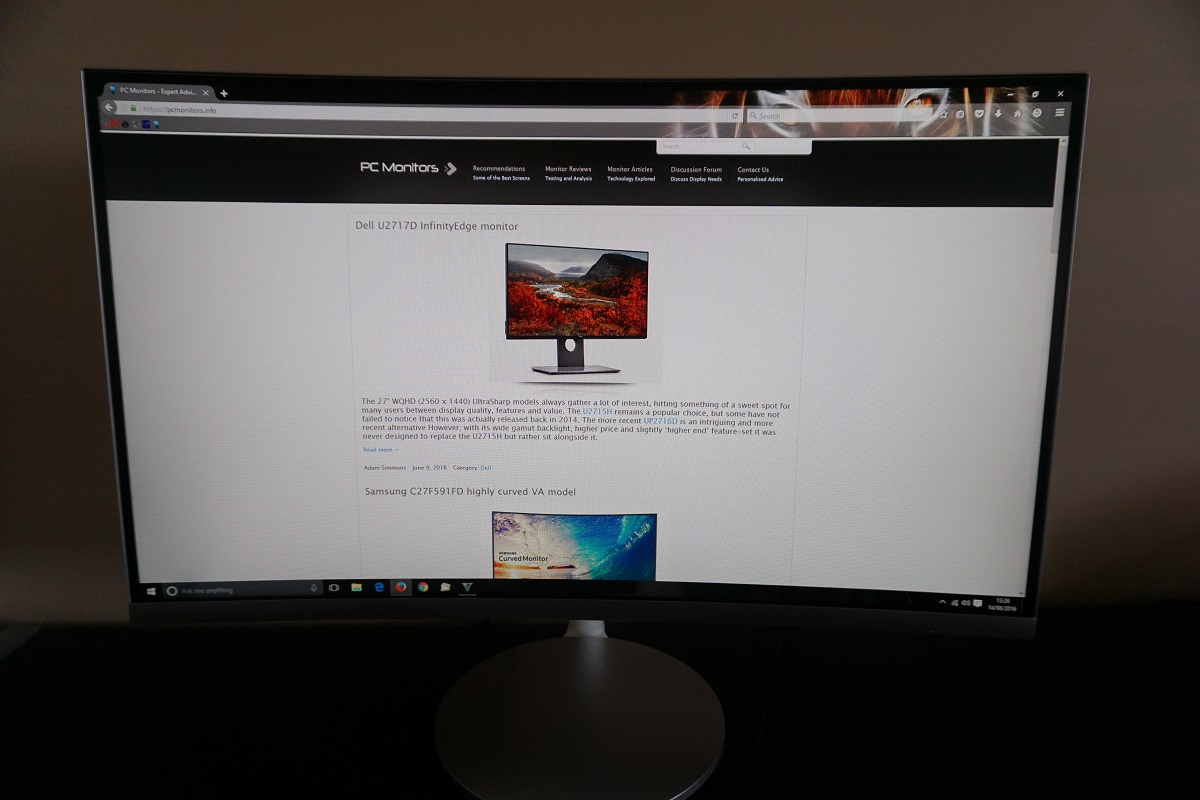
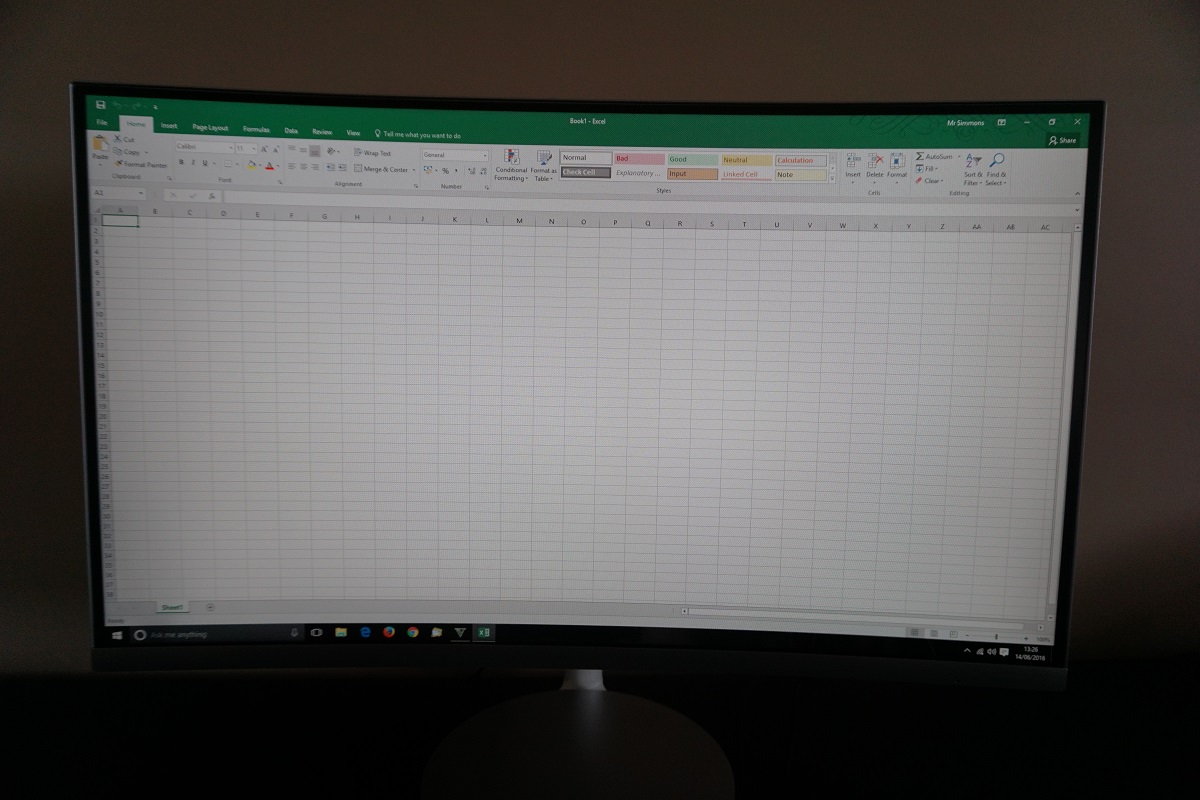
We found the curve again completely natural and easy to adapt to (if accommodation was fifty-fifty required, which is questionable) when watching movies and playing games as well. It isn't such a steep curve that it wraps around your face or anything, simply it does envelop your view a bit more than a flatter screen would. This gave a sort of actress depth to the experience, but non in a way that dramatically impacted the overall 'experience' of the movie or game. It is hard to describe actually – we liked the effect, but found it quite subtle really. Whatever strange interlacing patterns in these images (and indeed those above) are moiré from the camera rather than artifacts on the monitor itself.
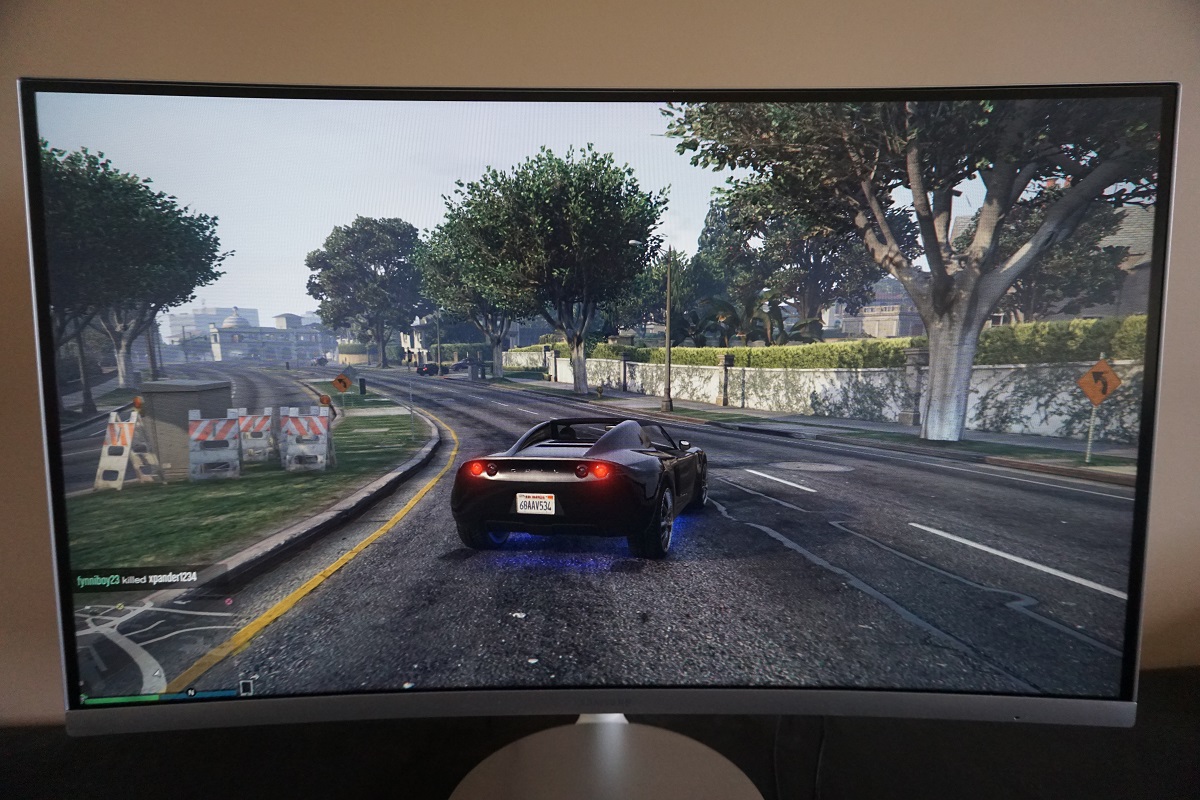


Video review
The video below summarises some of the central points raised in this written review and shows the monitor in action. The video review is designed to complement the written piece and is not nigh equally comprehensive.
Conclusion
It seems that last year's curved 27" models from Samsung were testing the water, seeing how consumers react to the idea of having a curved rather than apartment screen. The Samsung C27F591FD (CF591) represents an development of these, with a significantly steeper curve. Although the curve is more of a feature this fourth dimension around, it does remain quite a subtle ane. Using the monitor felt natural to u.s., whilst nosotros feel the bend brought a flake of extra depth to games and movies. This was something we didn't really experience with the older (less curved) models, equally the curve was only besides subtle to notice at all.
Whether or not curved monitors are your thing (perhaps you're quite indifferent to them), the screen itself impressed on many fronts. The image took a scrap of tweaking, as it was too bright and cool-looking out of the box, but following this the richness and variety of shades displayed was very pleasing. The generous (beyond sRGB – but non 'wide gamut' in the traditional sense) colour gamut and low-cal matte screen surfaces helped provide a vivid but not overblown await to the epitome. The VA panel helped deliver these colours in quite a 'punchy' style and indeed the consistency was about as practiced every bit we've seen from a VA model of this size.
Where shades actually caught the eye was in 'high-contrast' situations – with the contrast operation being a known strength of VA panels such as this. In this respect things were equally we expected, with strong static contrast of ~3000:1 (every bit specified) and a backlight that remains flicker-free at all brightness levels. This helped the monitor deliver quite deep-looking blacks and dark shades and helped lighter shades 'popular' out amid them. The matte screen surface was not only light; it was besides smooth – presenting light shades without the graininess associated with some matte surfaces.
Responsiveness is never the strong signal of VA technology and that was certainly the case here. In that location was a scrap of trailing from slower than optimal pixel transitions, but this was not as pronounced equally we've seen on some VA models and generally bars to darker shades. At that place were also some traces of overshoot. Overall, though, nosotros'd see this was one of the better balanced VA models nosotros've come beyond in terms of responsiveness. This helped the monitor make utilise of its refresh rate, which is 'officially' 72Hz with FreeSync enabled and can be 'overclocked' to that without. The monitor worked as you would hope with FreeSync, providing an experience between 48 and 72Hz (FPS) that was free from the stuttering or tearing that comes with a static refresh charge per unit. Input lag was too low, with the betoken delay clearly being minimal and the pixel response time bookkeeping for the vast majority of the input lag readings nosotros took.
Overall we experience this monitor delivers one of the nearly engaging 'Total HD' experiences out there. It may not exist the best pick for colour-critical work (although can exist used for some if you're a hobbyist) nor will it win any wars of responsiveness with the higher refresh rate gaming-oriented screens. But when it comes to general utilize and providing an engrossing gaming and moving-picture show watching experience, this model hits the spot. It certainly isn't the cheapest of models nor does it offer the sort of ergonomic flexibility some would hope for given the toll. However; we do notwithstanding feel it does enough to justify this cost tag.
The bottom line; a screen with a curve that is subtle but noticeable, with much more to offering beyond merely that.
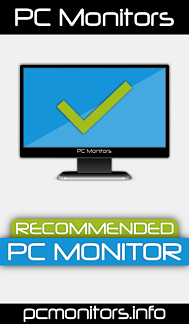
| Positives | Negatives |
| Strong vibrancy and varied shade representation, particularly following appropriate tweaking in the OSD – a generous colour gamut without wandering into truthful broad gamut territory | Slight deviation from the ideal '2.ii' bend fifty-fifty later on tweaking and slight loss of saturation towards edges and bottom of screen – but about as little of this as nosotros've seen from a 27" VA panel |
| Strong contrast performance providing a fairly inky wait to dark shades and allowing lighter shades to 'pop' out from this. The screen surface was low-cal and left such light shades appearing relatively shine rather than noticeably grainy | Modest 'black crush', simply a level of detail maintained throughout the screen that puts not-VA panels and in fact many VA panels to shame |
| A fairly responsive performer overall given the panel blazon, with some rapid pixel transitions and very low indicate delay – plus FreeSync and 72Hz capability working every bit you'd hope | Slight overshoot and extra trailing in places, but not to the extent seen on many VA models – sensitivity to this does vary |
| A squeamish design overall, we feel – and nosotros really liked the bend and institute information technology to add together to the experience without proving distracting or unnatural | Somewhat redundant 'dish' stand base, limited ergonomic flexibility and a chip pricier than many Full HD models |
As an Amazon Acquaintance I earn from qualifying purchases made using the below link.

Source: https://pcmonitors.info/reviews/samsung-c27f591fd/